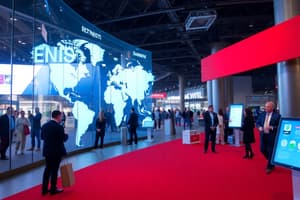Podcast
Questions and Answers
What is the primary purpose of conducting a market analysis before exporting products?
What is the primary purpose of conducting a market analysis before exporting products?
- To identify demand, competition, and regulatory factors in foreign markets (correct)
- To determine pricing strategies for the domestic market
- To create advertising campaigns for the export market
- To analyze the financial performance of domestic competitors
Which factor is NOT considered in the cost-benefit analysis of export/import strategies?
Which factor is NOT considered in the cost-benefit analysis of export/import strategies?
- Production speed (correct)
- Tariffs and taxes
- Transportation costs
- Market share gains
Why is legal and regulatory compliance crucial for exporters?
Why is legal and regulatory compliance crucial for exporters?
- It prevents tariffs from increasing unexpectedly
- It boosts market share in the domestic market
- It enhances product appeal to consumers
- It ensures adherence to international trade laws and navigates restrictions (correct)
What advantage does market diversification provide to businesses engaged in exporting?
What advantage does market diversification provide to businesses engaged in exporting?
What does achieving economies of scale through exporting primarily refer to?
What does achieving economies of scale through exporting primarily refer to?
What effect can successful entry into a foreign market have on a company's brand image?
What effect can successful entry into a foreign market have on a company's brand image?
What is a major challenge associated with exporting goods to foreign markets?
What is a major challenge associated with exporting goods to foreign markets?
Which factor can negatively impact the profitability of export transactions?
Which factor can negatively impact the profitability of export transactions?
How do trading companies assist businesses entering international markets?
How do trading companies assist businesses entering international markets?
What is one of the roles of trading companies in global trade?
What is one of the roles of trading companies in global trade?
What risk can political and economic instability in a target market pose?
What risk can political and economic instability in a target market pose?
What logistical aspect do trading companies often manage when exporting goods?
What logistical aspect do trading companies often manage when exporting goods?
What distinguishes franchising from licensing?
What distinguishes franchising from licensing?
Which statement about the control exerted by licensors and franchisors is accurate?
Which statement about the control exerted by licensors and franchisors is accurate?
Which of the following is a characteristic of licensing agreements?
Which of the following is a characteristic of licensing agreements?
Which industry commonly utilizes licensing agreements?
Which industry commonly utilizes licensing agreements?
In terms of brand consistency, how does licensing differ from franchising?
In terms of brand consistency, how does licensing differ from franchising?
What is a primary responsibility of franchisees in a franchising model?
What is a primary responsibility of franchisees in a franchising model?
Which of these best describes the financial commitment involved in franchising compared to licensing?
Which of these best describes the financial commitment involved in franchising compared to licensing?
What type of support is less emphasized in licensing agreements compared to franchising?
What type of support is less emphasized in licensing agreements compared to franchising?
How does the transfer of intellectual property differ between licensing and franchising?
How does the transfer of intellectual property differ between licensing and franchising?
What is one of the primary roles of Multinational Corporations (MNCs) in globalization?
What is one of the primary roles of Multinational Corporations (MNCs) in globalization?
How do MNCs typically optimize efficiency and reduce costs in their operations?
How do MNCs typically optimize efficiency and reduce costs in their operations?
In what way do MNCs contribute to the job market in countries where they operate?
In what way do MNCs contribute to the job market in countries where they operate?
What is a significant advantage of MNCs engaging in cross-border operations?
What is a significant advantage of MNCs engaging in cross-border operations?
How do MNCs facilitate knowledge sharing in their global operations?
How do MNCs facilitate knowledge sharing in their global operations?
What role do MNCs play in technology transfer across borders?
What role do MNCs play in technology transfer across borders?
Which of the following best describes market integration facilitated by MNCs?
Which of the following best describes market integration facilitated by MNCs?
What is a critical factor in the resource allocation strategies employed by MNCs?
What is a critical factor in the resource allocation strategies employed by MNCs?
How do MNCs contribute to capital flows across borders?
How do MNCs contribute to capital flows across borders?
Flashcards
Export/Import Strategies
Export/Import Strategies
Methods businesses use to sell products in foreign markets (export) or buy products from foreign markets (import).
Market Analysis
Market Analysis
Evaluating the demand, competition, and regulations of a foreign market before exporting or importing.
Product Adaptation
Product Adaptation
Adjusting a product to meet the cultural, legal, and technical requirements of a foreign market.
Cost-Benefit Analysis (Export/Import)
Cost-Benefit Analysis (Export/Import)
Comparing the costs of exporting/importing (transportation, tariffs) to potential revenue and market gains.
Signup and view all the flashcards
Legal and Regulatory Compliance
Legal and Regulatory Compliance
Following international trade laws, regulations, import/export restrictions, and customs rules.
Signup and view all the flashcards
Foreign Market Entry
Foreign Market Entry
Entering a specific market outside of the company's home country for business purposes.
Signup and view all the flashcards
Cultural Barriers
Cultural Barriers
Differences in language, customs, and preferences that make marketing and selling in foreign markets difficult.
Signup and view all the flashcards
Logistical Complexities
Logistical Complexities
Navigating export processes like transportation, customs, and supply chain management—often time-consuming and costly.
Signup and view all the flashcards
Currency Fluctuations
Currency Fluctuations
Changes in exchange rates that can affect the profitability of international transactions.
Signup and view all the flashcards
Trading Companies
Trading Companies
Intermediaries that facilitate product entry into international markets, handling complexities and risks.
Signup and view all the flashcards
Market Entry Facilitation
Market Entry Facilitation
The process of making it easier for companies to enter new markets.
Signup and view all the flashcards
Risk Mitigation
Risk Mitigation
Actions taken to lessen the potential losses and problems of international trade.
Signup and view all the flashcards
Licensing Definition
Licensing Definition
A contract where a licensor lets a licensee use their intellectual property (like patents) for a fee.
Signup and view all the flashcards
Franchising Definition
Franchising Definition
A business model where a franchisor lets a franchisee use their entire business method, brand, and operations.
Signup and view all the flashcards
Licensing IP Transfer
Licensing IP Transfer
The licensor retains ownership of the intellectual property; the licensee only gets the right to use it.
Signup and view all the flashcards
Franchising Business Model Transfer
Franchising Business Model Transfer
Franchising includes the complete business model, brand, marketing, and operational support to the franchisee.
Signup and view all the flashcards
Licensing Control
Licensing Control
The licensor has less control over how the licensee operates and markets the product.
Signup and view all the flashcards
Franchising Control
Franchising Control
Franchisors maintain more control, offering ongoing support in training, marketing, and operations.
Signup and view all the flashcards
Licensing Risk
Licensing Risk
Licensing typically involves lower risk and investment for both parties—the Licensee bears responsibility for manufacturing and marketing.
Signup and view all the flashcards
Franchising Investment
Franchising Investment
Franchising involves higher investment for franchisees who benefit from a proven brand and method.
Signup and view all the flashcards
Licensing vs. Franchising Brand Consistency
Licensing vs. Franchising Brand Consistency
In licensing, brand consistency depends heavily on licensee's efforts, while franchising provides assistance to ensure the use of a standard brand.
Signup and view all the flashcards
MNC Role in Globalization
MNC Role in Globalization
Multinational Corporations (MNCs) play a significant role in connecting global economies through various activities.
Signup and view all the flashcards
Global Market Presence
Global Market Presence
MNCs operate in multiple countries, extending their reach and leveraging their resources across diverse markets.
Signup and view all the flashcards
Cross-Border Operations
Cross-Border Operations
Multinational Corporations (MNCs) conduct business activities (production, distribution, marketing) across international borders.
Signup and view all the flashcards
Resource Allocation (Global)
Resource Allocation (Global)
MNCs manage their resources (materials, labor) on an international scale to optimize efficiency and lower costs.
Signup and view all the flashcards
Technology Transfer (MNCs)
Technology Transfer (MNCs)
Multinational Corporations (MNCs) introduce advanced technologies to new areas, assisting in industry development.
Signup and view all the flashcards
Job Creation (MNCs)
Job Creation (MNCs)
Multinational Corporations generate employment in various countries, including direct positions & supply chain jobs.
Signup and view all the flashcards
Knowledge Sharing (MNCs)
Knowledge Sharing (MNCs)
Multinational Corporations foster knowledge exchange between their subsidiaries for better development of local expertise.
Signup and view all the flashcards
Market Integration (MNCs)
Market Integration (MNCs)
Multinational Corporations connect diverse markets, establishing global supply chains for products and services.
Signup and view all the flashcards
Capital Flows (MNCs)
Capital Flows (MNCs)
Multinational Corporations promote capital movement across countries, enabling investment and economic growth.
Signup and view all the flashcardsStudy Notes
International Marketing - Unit 02: Entering Global Markets
- Unit Focus: Global market entry strategies, including export/import decisions, trading companies, licensing/franchising, joint ventures/FDI, multinational corporations, and mergers/acquisitions.
- Learning Objectives: Understand export/import strategies, analyze advantages/challenges, analyze the role of trading companies as intermediaries, compare licensing/franchising in international business.
- Module Overview: The module explores global market entry strategies and the impact of multinational corporations and mergers/acquisitions in the international business landscape.
- Learning Outcomes: Participants will be able to evaluate/choose appropriate export/import strategies, critically analyze international trade with trading companies, understand licensing/franchising, and understand decision-making processes in FDI/multinational corporations.
- Pre-Unit Material: "International Business" by John B. Cullen and K. Praveen Parboteeah, and "Global Marketing Management" by Keegan and Mark C. Green.
- Key Topics: Export/Import Strategies, International Intermediaries (Trading Companies), Licensing/Franchising, Joint Ventures/FDI, Multinational Corporations (MNCs) and Globalization, Mergers/Acquisitions (M&A).
- Decision-Making Process: Market analysis (demand, competition, regulations), product adaptation, cost-benefit analysis (transportation, tariffs, taxes), legal and regulatory compliance, and risk assessment (currency, political instability).
- Advantages of Exporting: Market diversification, economies of scale, global brand recognition, increased sales/revenue.
- Challenges of Exporting: Cultural barriers, logistical complexities in transportation/customs.
- International Intermediaries (Trading Companies): Facilitate market entry, mitigate risks, manage documentation, handle logistics, provide market insights.
- Licensing/Franchising: Licensing involves granting intellectual property rights for a fee, while franchising involves transferring a business model, brand, marketing support.
- Joint Ventures/FDI: Joint ventures (JV) share risks and costs with local partners, foreign direct investment (FDI) provides complete ownership/control.
- Multinational Corporations (MNCs): Operate in multiple countries, leverage resources/expertise, cross-border operations, resource allocation, technology transfer, job creation, knowledge sharing.
- Mergers & Acquisitions (M&A): Consolidation of companies through mergers/acquisitions/takeovers, expansion into new markets, access to technologies/resources, synergy/cost efficiency, diversification, and brand strengthening.
- Successful/Unsuccessful Examples of Market Expansion Strategies: Case studies (e.g., Disney acquiring Pixar, Tencent investing in Supercell).
- Ethical Considerations in Global Market Entry: Cultural differences, ethical implications and regulatory barriers.
Additional Information
- Glossary: Key terms (Export, Import, Trading Company, Licensing, Franchising, Joint Venture, Foreign Direct Investment, Multinational Corporation, Globalization etc.)
- Self-Assessment Questions: Questions focused on the impact of cultural adaptation, considerations for choosing market entry strategies, the role of trading companies, the influence of MNCs on the global economy, and examples of successful M&A strategies.
- Post-Unit Reading Material: Relevant study resources like the World Trade Organization (WTO) and Harvard Business Review (HBR).
- Discussion Forum Topics: Technology's impact on global market entry strategies, ethical concerns in international business collaborations.
Studying That Suits You
Use AI to generate personalized quizzes and flashcards to suit your learning preferences.





